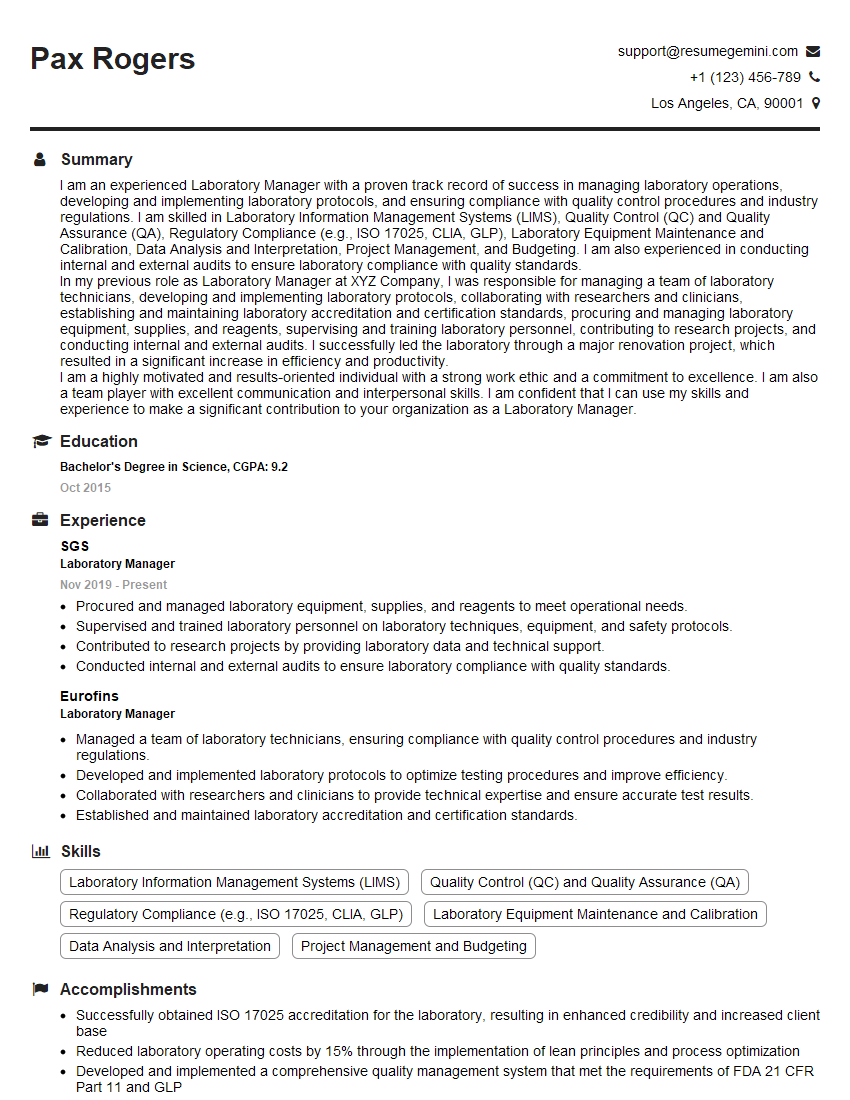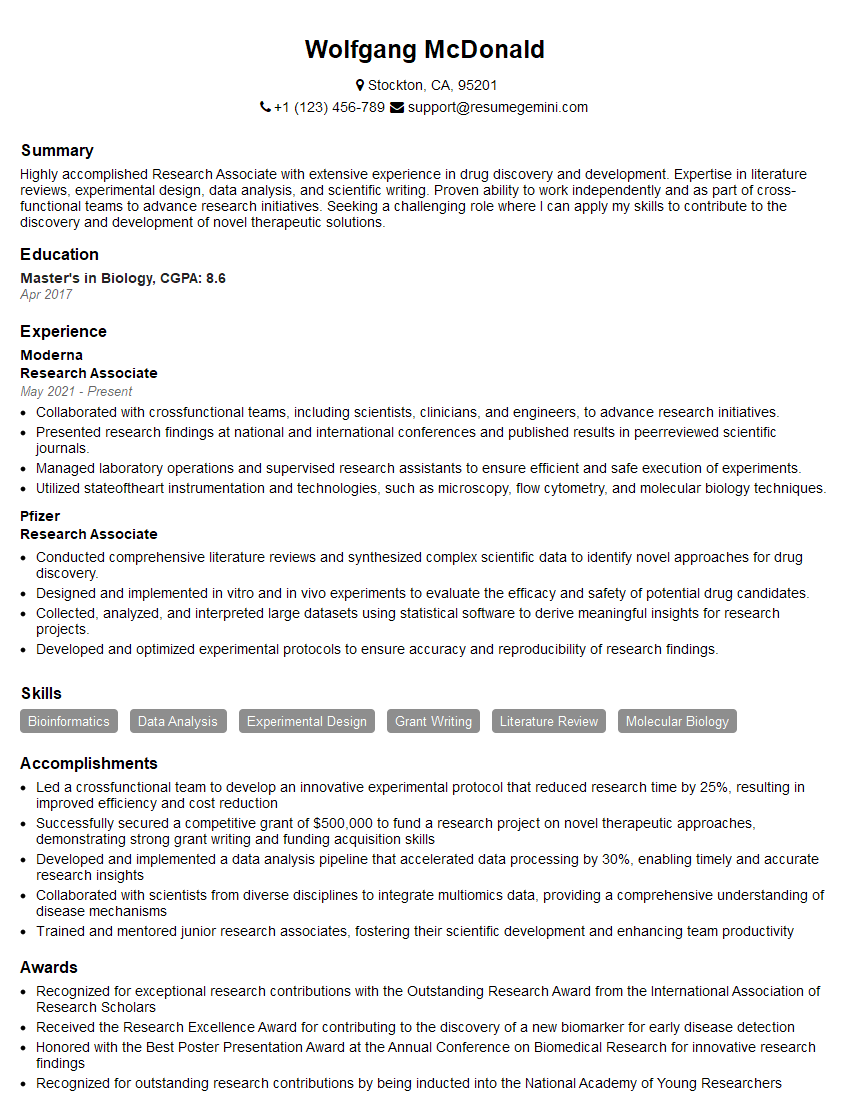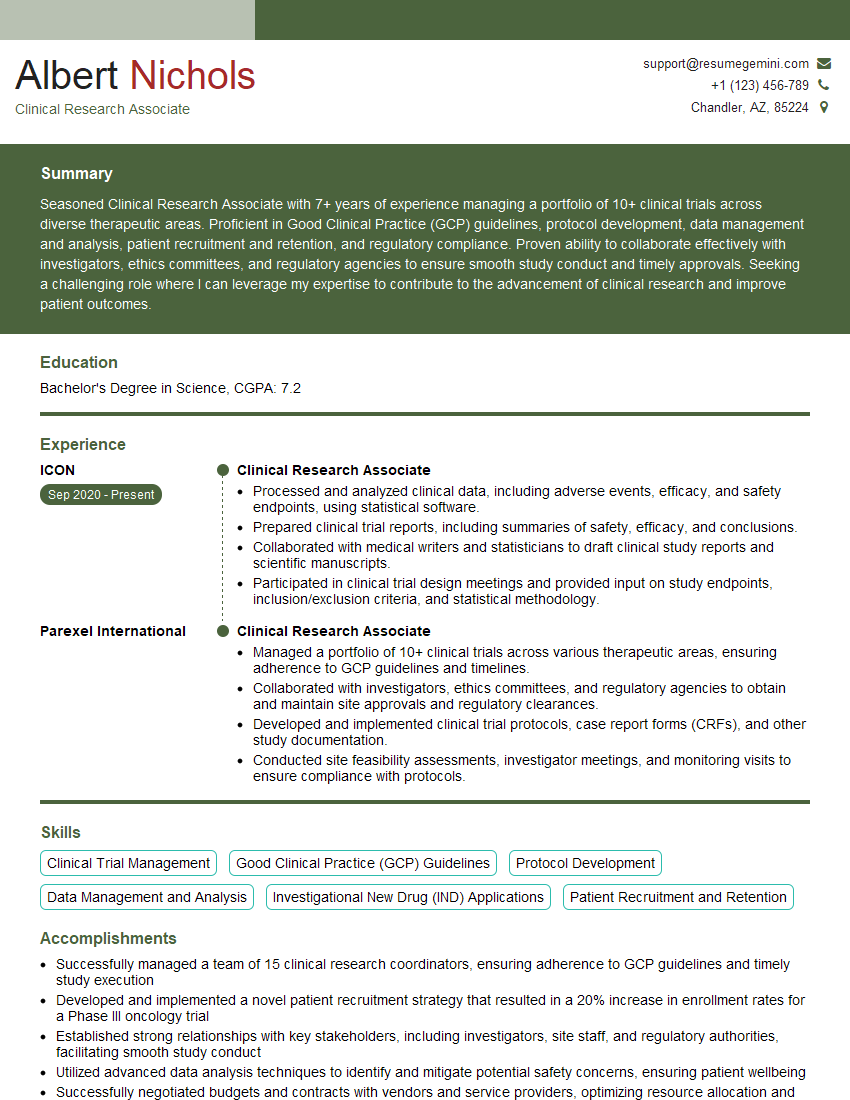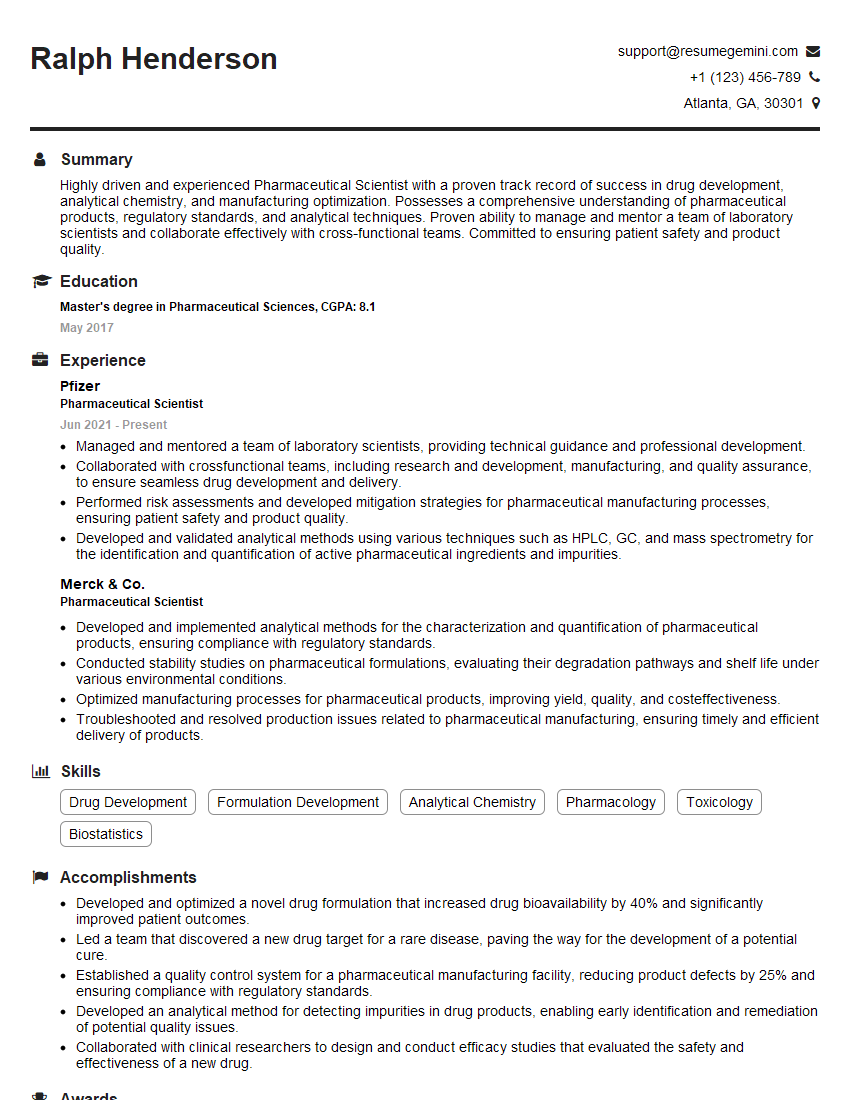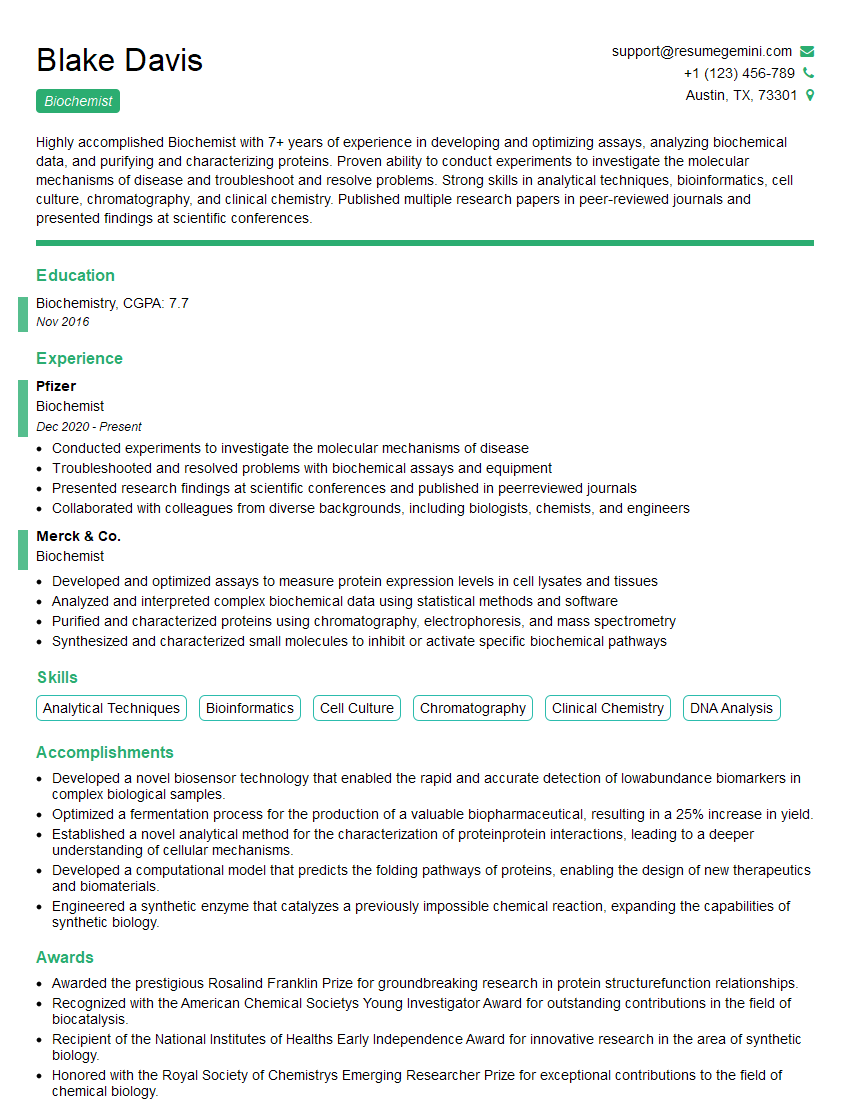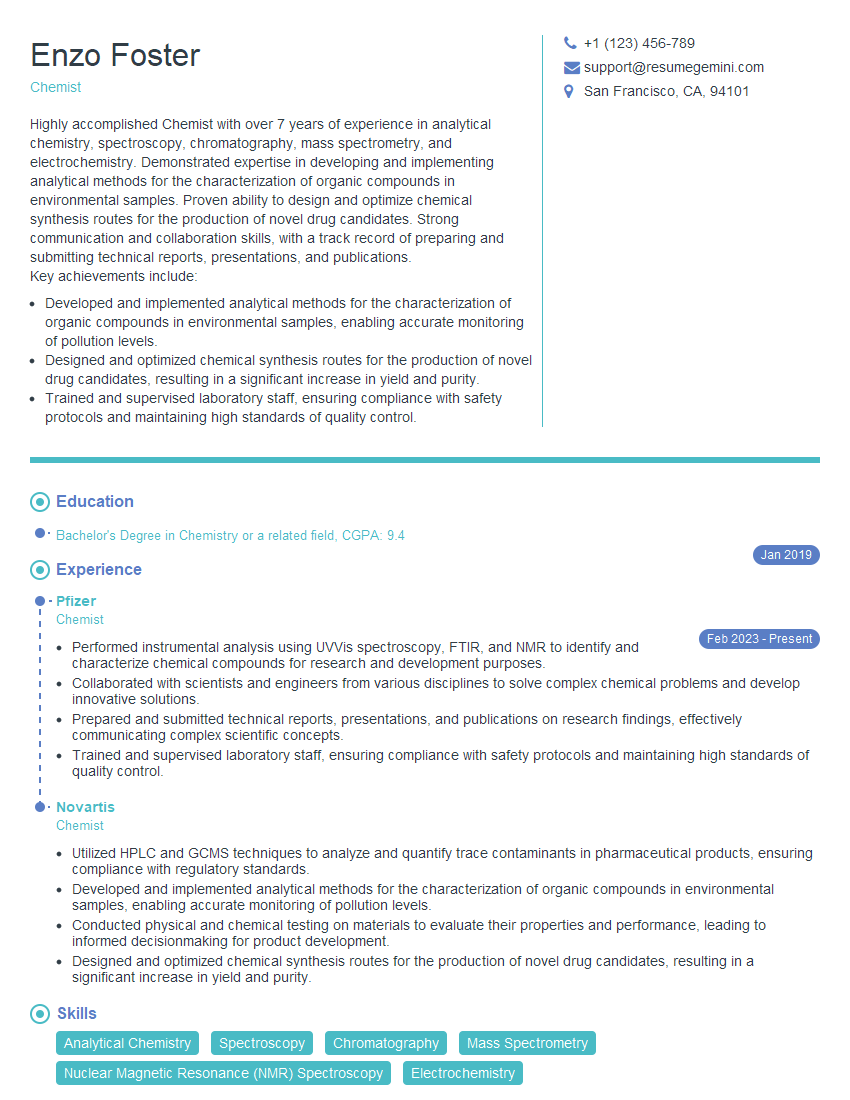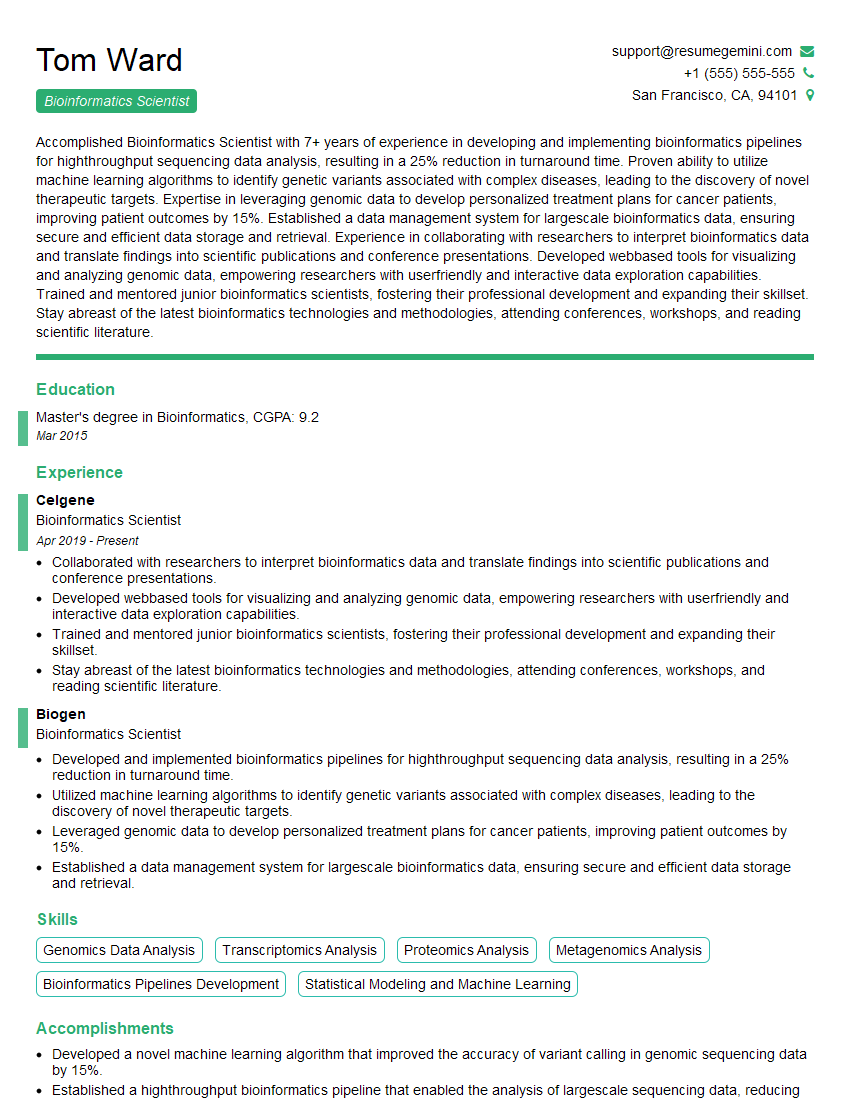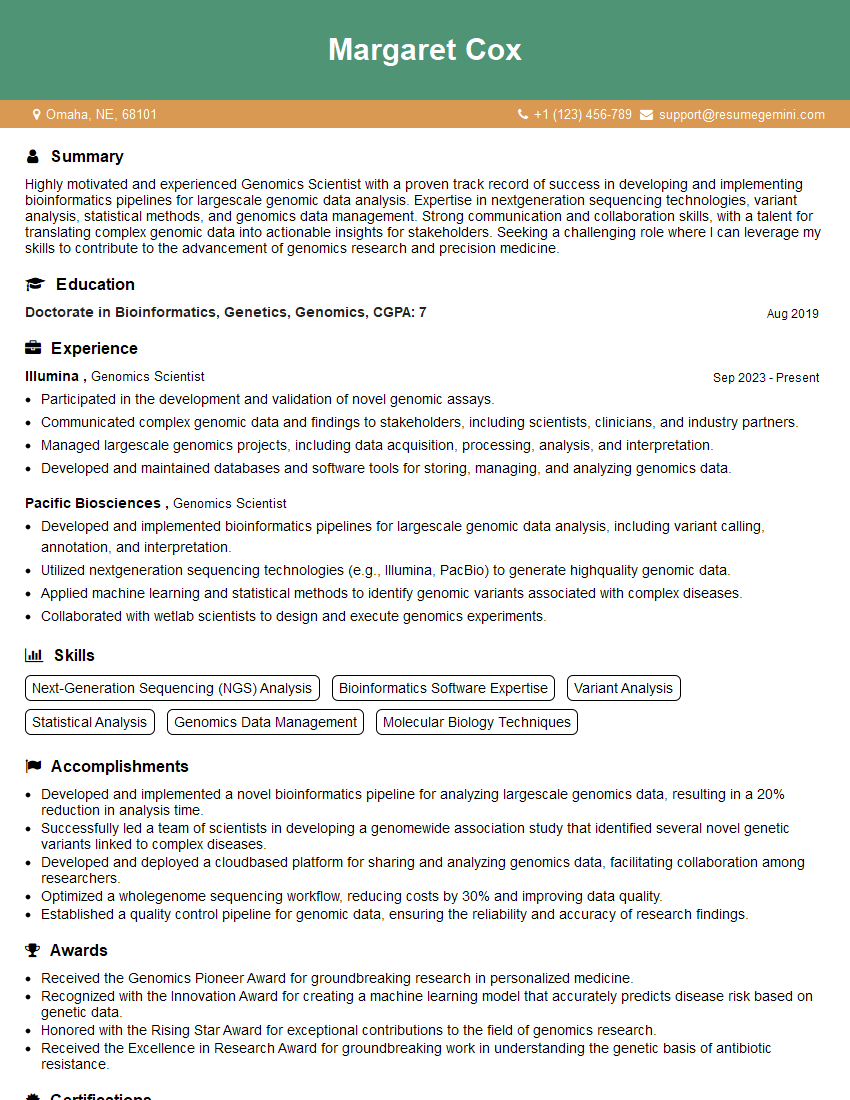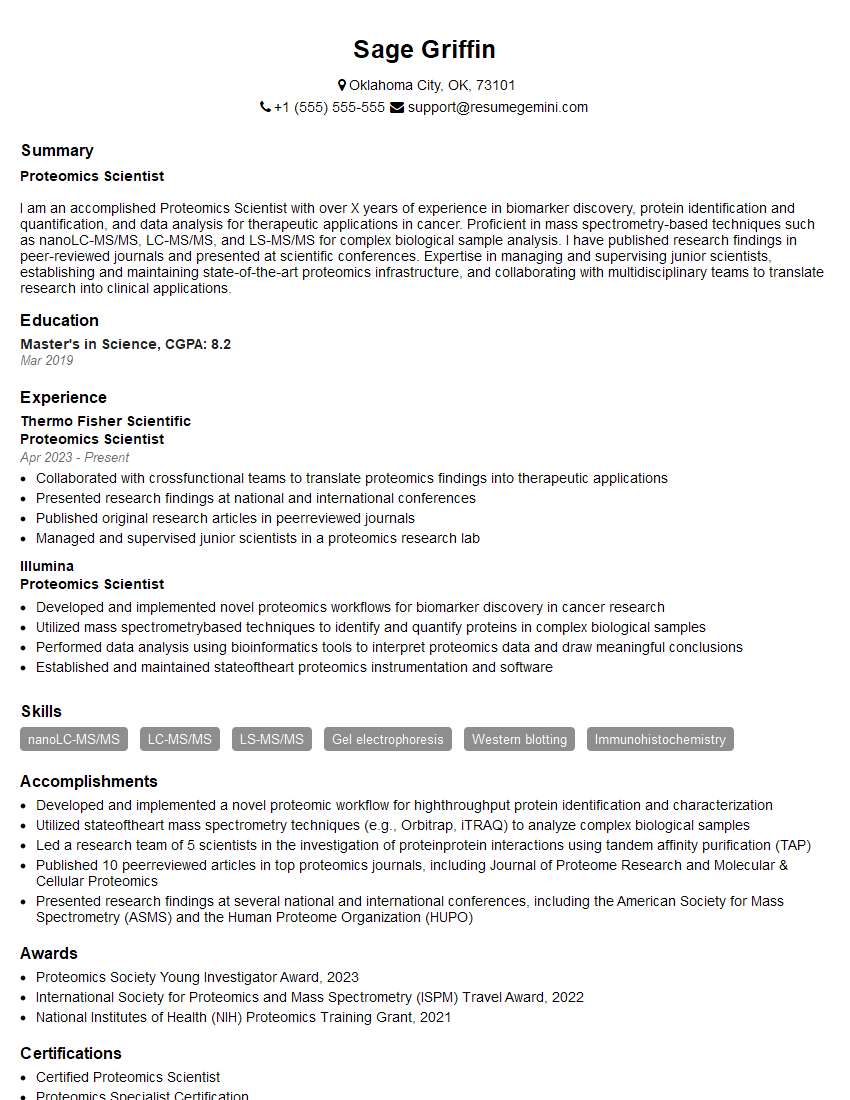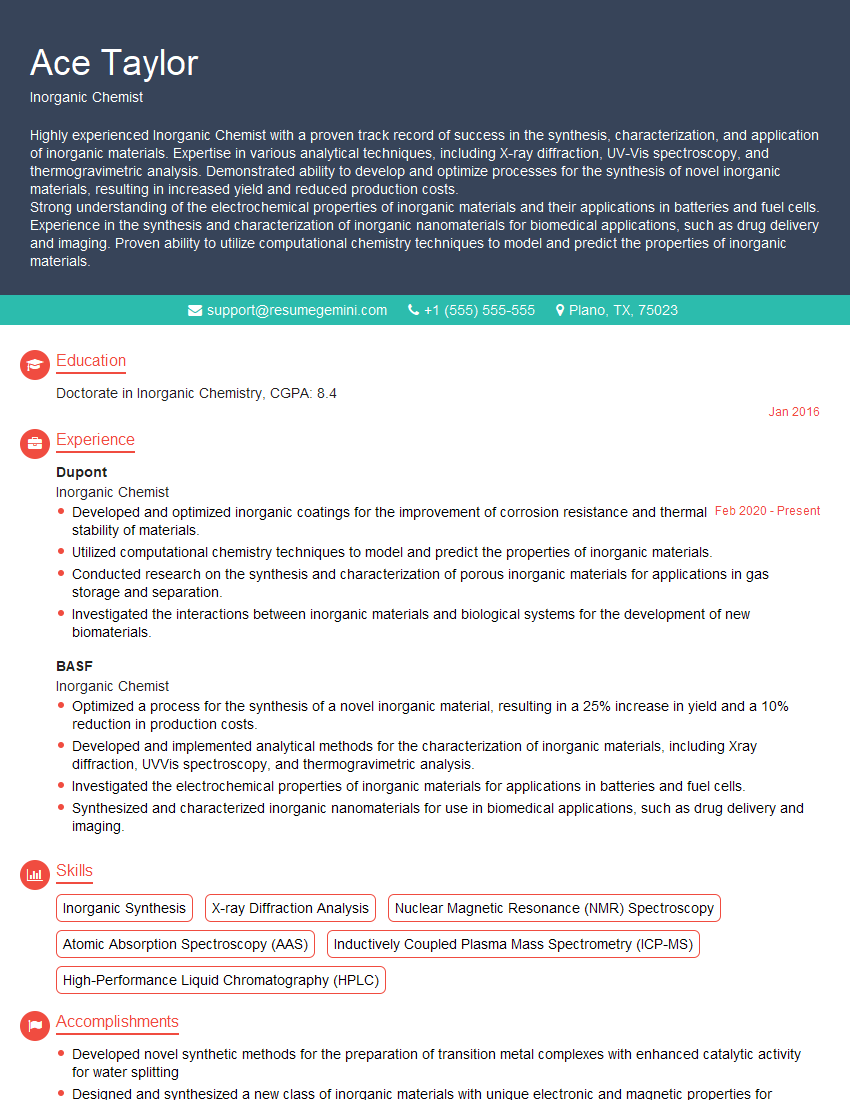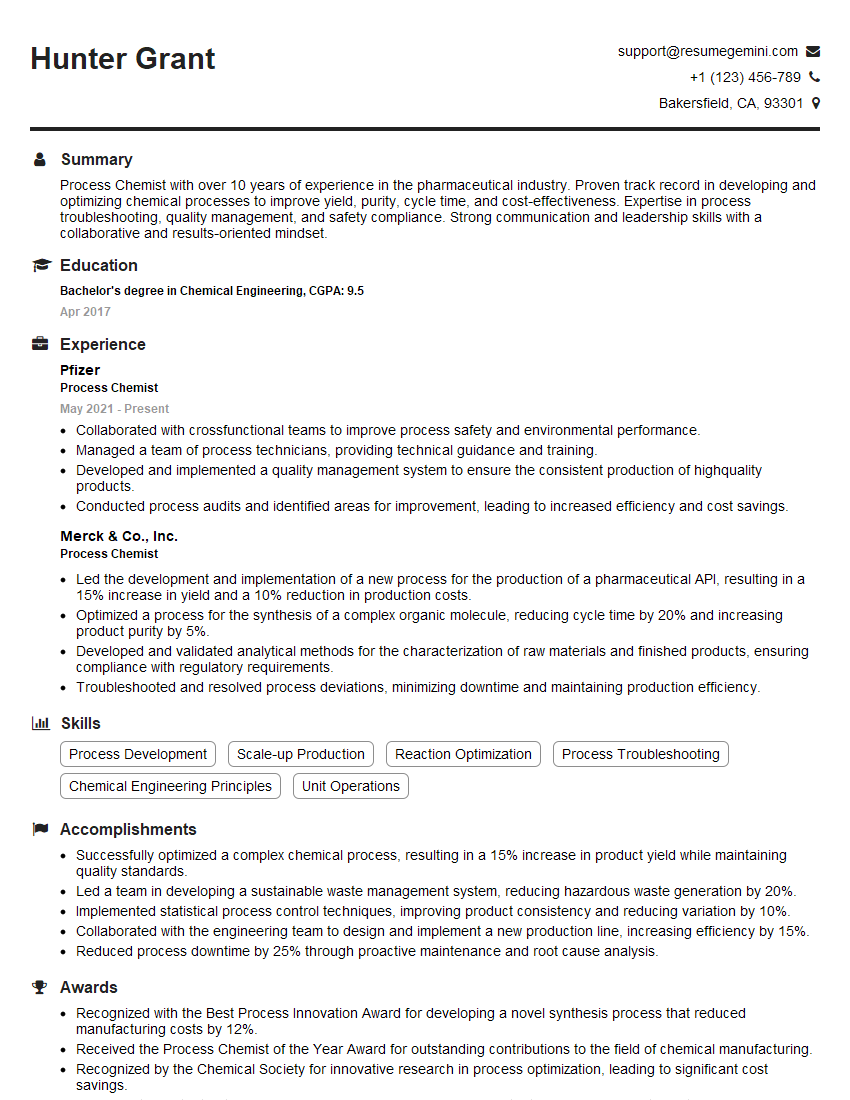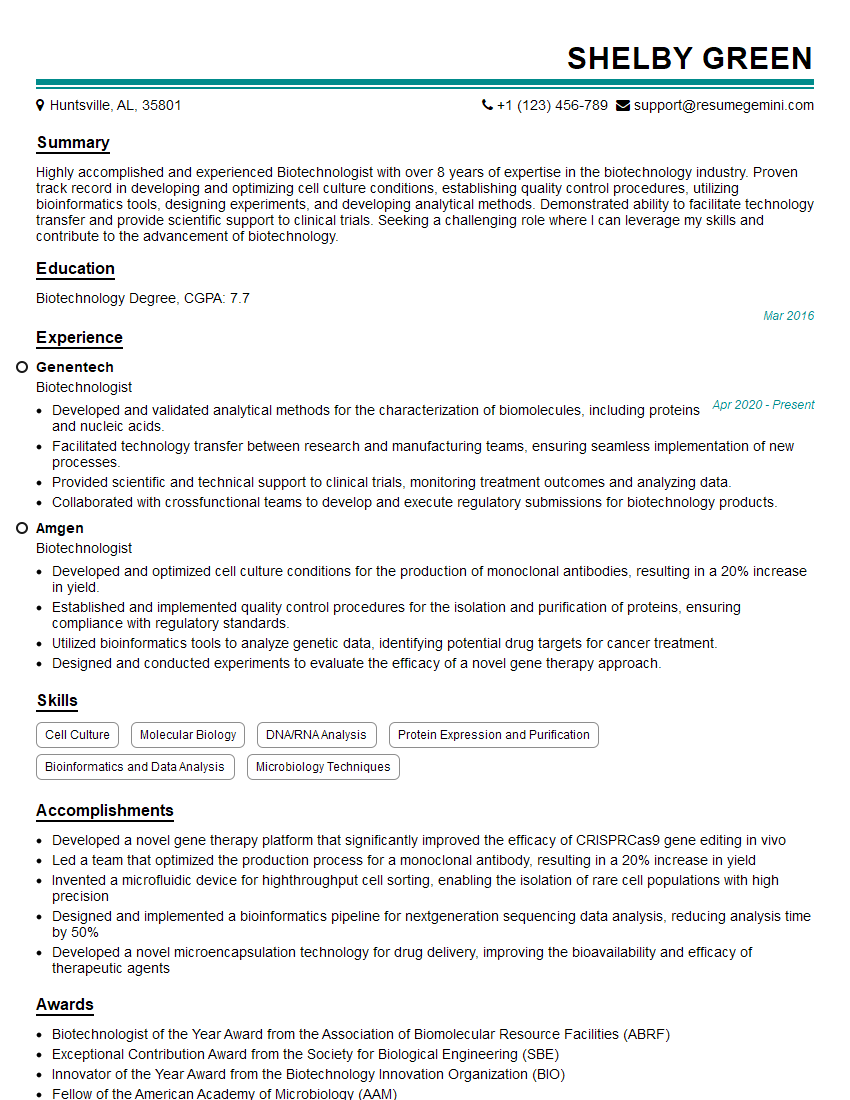Preparation is the key to success in any interview. In this post, we’ll explore crucial Chemistry and Molecular Biology interview questions and equip you with strategies to craft impactful answers. Whether you’re a beginner or a pro, these tips will elevate your preparation.
Questions Asked in Chemistry and Molecular Biology Interview
Q 1. Explain the principles of PCR.
PCR, or Polymerase Chain Reaction, is a revolutionary technique in molecular biology that allows us to amplify a specific DNA sequence exponentially in a test tube. Imagine you have a tiny fragment of DNA, like a needle in a haystack, and you need millions of copies to study it. That’s what PCR does.
The principle lies in using a heat-stable DNA polymerase enzyme (like Taq polymerase) to repeatedly copy a target DNA sequence. This involves three key steps, repeated many times:
- Denaturation: Heating the DNA to separate the double-stranded helix into two single strands. Think of it like unzipping a zipper.
- Annealing: Cooling the reaction to allow short, single-stranded DNA sequences called primers to bind to their complementary sequences on the target DNA. Primers act like the starting point for the copying process.
- Extension: Raising the temperature slightly to allow the DNA polymerase to synthesize new DNA strands, using the primers as a template. This is where the magic happens – the DNA is copied.
This cycle is repeated 25-35 times, resulting in millions or even billions of copies of the target DNA sequence. PCR finds applications in various fields, including disease diagnostics (detecting pathogens like COVID-19), forensic science (DNA fingerprinting), and genetic engineering (cloning genes).
Q 2. Describe the process of protein purification.
Protein purification is the process of isolating a specific protein from a complex mixture, such as a cell lysate. Imagine you have a fruit salad and you only want the strawberries. Purification separates the strawberries (your protein of interest) from the rest of the fruit (other proteins and cellular components). The goal is to obtain a pure sample of the protein for further analysis or application.
The process typically involves several steps:
- Cell lysis: Breaking open the cells to release the proteins. This can be achieved through various methods like sonication, enzymatic digestion, or chemical lysis.
- Centrifugation: Separating cellular components based on their size and density. Larger components, like cell debris, pellet at the bottom, while proteins remain in the supernatant (liquid).
- Chromatography: This is the core of protein purification, employing different techniques based on the protein’s properties, such as size, charge, and affinity (see question 3 for more details).
- Dialysis: Removing unwanted small molecules, like salts, from the protein solution.
- Final concentration and storage: The purified protein is concentrated and stored under appropriate conditions to maintain its activity and integrity.
The choice of purification techniques depends on the specific protein, its properties, and the desired purity level. It’s often an iterative process, combining several techniques to achieve optimal results. For instance, you might use ion-exchange chromatography followed by size-exclusion chromatography for a high-purity protein.
Q 3. What are the different types of chromatography techniques?
Chromatography is a powerful technique for separating different components of a mixture based on their physical and chemical properties. It’s like separating colored candies by their color using different methods. There are numerous types of chromatography, but some of the most common include:
- Size-Exclusion Chromatography (SEC): Separates proteins based on their size. Smaller proteins are slowed down more than larger ones as they travel through a column packed with porous beads, allowing for separation.
- Ion-Exchange Chromatography (IEC): Separates proteins based on their net charge. A charged column matrix attracts proteins with opposite charges, while others pass through. For example, a positively charged column will retain negatively charged proteins.
- Affinity Chromatography: Separates proteins based on their specific binding affinity to a ligand immobilized on a column. For example, if you want to purify a protein that binds to a specific antibody, you can use that antibody as the ligand.
- High-Performance Liquid Chromatography (HPLC): A high-resolution technique used for separating and analyzing a wide range of compounds, including proteins. It uses high pressure to improve separation efficiency.
Each technique has its advantages and limitations, and the choice depends on the specific application and properties of the molecules being separated. For instance, if you need to separate proteins with subtle differences in size, SEC might not be the best choice. Instead, HPLC might be more appropriate.
Q 4. Explain the central dogma of molecular biology.
The central dogma of molecular biology describes the flow of genetic information within a biological system. It’s a fundamental principle that explains how information is passed from DNA to RNA to protein. Think of it as a recipe book (DNA) being used to create a shopping list (RNA) which is then used to prepare a meal (protein).
The main steps are:
- Replication: DNA is duplicated to produce identical copies, ensuring genetic information is passed on during cell division.
- Transcription: DNA is transcribed into messenger RNA (mRNA). This involves creating an RNA copy of a specific DNA segment. The mRNA carries the genetic information from the nucleus to the ribosomes.
- Translation: mRNA is translated into a protein. Ribosomes read the mRNA sequence and assemble amino acids into a polypeptide chain, forming the functional protein. Each three-nucleotide sequence (codon) on the mRNA specifies a specific amino acid.
While the central dogma provides a simplified model, exceptions exist. For instance, reverse transcription involves the synthesis of DNA from an RNA template, which is seen in retroviruses like HIV.
Q 5. What are the different types of chemical bonds?
Chemical bonds are the forces that hold atoms together in molecules. They are crucial for the structure and function of all matter, including biological molecules. Several types of chemical bonds exist:
- Covalent bonds: The strongest type of bond, formed by the sharing of electrons between atoms. For example, the bond between carbon and hydrogen in methane (CH4) is a covalent bond.
- Ionic bonds: Formed by the electrostatic attraction between oppositely charged ions. An example is the bond between sodium (Na+) and chloride (Cl–) ions in sodium chloride (NaCl).
- Hydrogen bonds: Relatively weak bonds formed between a hydrogen atom covalently bonded to an electronegative atom (like oxygen or nitrogen) and another electronegative atom. These are vital for the structure of proteins and DNA.
- Van der Waals forces: Weak, temporary attractions between molecules due to fluctuations in electron distribution. These forces play a role in molecular interactions and protein folding.
The type of bond formed depends on the electronegativity difference between the atoms involved. For instance, atoms with similar electronegativities tend to form covalent bonds, whereas atoms with significantly different electronegativities tend to form ionic bonds.
Q 6. Describe the properties of water and its importance in biological systems.
Water is a remarkable molecule essential for life. Its unique properties stem from its polarity and ability to form hydrogen bonds. Think of water as the ultimate life-support system for biological systems.
Key properties and their biological significance:
- High specific heat capacity: Water can absorb a significant amount of heat without a large temperature change. This helps regulate temperature fluctuations in organisms and environments.
- High heat of vaporization: A large amount of heat is required to convert liquid water to vapor. This allows for efficient evaporative cooling in organisms (sweating).
- Excellent solvent: Water’s polarity allows it to dissolve many ionic and polar substances, making it an ideal medium for biochemical reactions.
- Cohesion and adhesion: Water molecules stick to each other (cohesion) and other polar surfaces (adhesion). This is important for water transport in plants and maintaining surface tension.
In biological systems, water acts as a solvent for biochemical reactions, participates in metabolic processes, and maintains cell structure and function. Its properties are crucial for the survival and proper functioning of all living organisms.
Q 7. Explain the concept of pH and buffers.
pH is a measure of the acidity or alkalinity of a solution, ranging from 0 to 14. A pH of 7 is neutral, below 7 is acidic, and above 7 is alkaline. It’s essentially a scale that measures the concentration of hydrogen ions (H+) in a solution.
Buffers are solutions that resist changes in pH upon the addition of small amounts of acid or base. They are crucial for maintaining a stable pH in biological systems, where many processes are highly sensitive to pH changes. Think of buffers as shock absorbers for pH fluctuations.
How buffers work:
A buffer typically consists of a weak acid and its conjugate base, or a weak base and its conjugate acid. When a small amount of acid is added, the buffer’s conjugate base reacts with the added H+ ions, neutralizing the acid and preventing a significant pH drop. Similarly, when a small amount of base is added, the buffer’s weak acid reacts with the added OH– ions, neutralizing the base and preventing a significant pH increase.
Examples of biological buffers include bicarbonate buffer in blood and phosphate buffer in cells. These buffers are essential for maintaining the optimal pH required for various biochemical reactions and cellular processes.
Q 8. What are enzymes and how do they function?
Enzymes are biological catalysts, primarily proteins, that significantly speed up the rate of virtually all chemical reactions within cells. They achieve this by lowering the activation energy required for a reaction to proceed. Imagine a mountain pass between two valleys; the reaction is like getting from one valley to the other. The enzyme acts like a tunnel through the mountain, making the journey much easier and faster.
Enzymes function by binding to specific molecules called substrates at their active site. This binding forms an enzyme-substrate complex, which then undergoes a conformational change that facilitates the reaction. After the reaction is complete, the products are released, and the enzyme returns to its original state, ready to catalyze another reaction. The specificity of enzymes arises from the unique three-dimensional structure of their active site, which only accommodates specific substrates.
For example, the enzyme lactase breaks down lactose (milk sugar) into glucose and galactose. Without lactase, lactose intolerance occurs because the body can’t digest lactose efficiently.
Q 9. Describe the different types of enzyme kinetics.
Enzyme kinetics studies the rates of enzyme-catalyzed reactions. Several models describe this, the most common being Michaelis-Menten kinetics. This model describes the relationship between the initial reaction rate (velocity) and substrate concentration. It assumes a simple reaction mechanism involving the formation of an enzyme-substrate complex.
Michaelis-Menten Kinetics: This model is represented by the equation V0 = Vmax[S]/(Km + [S]), where V0 is the initial velocity, Vmax is the maximum velocity, [S] is the substrate concentration, and Km is the Michaelis constant (representing the substrate concentration at half Vmax). A low Km indicates high affinity between enzyme and substrate.
Other models exist to describe more complex scenarios, such as cooperative binding (seen in allosteric enzymes) where substrate binding to one site affects the binding of substrate to other sites, or irreversible inhibition where the inhibitor permanently alters the enzyme’s active site.
Q 10. Explain the principles of electrophoresis.
Electrophoresis separates charged molecules based on their size and charge using an electric field. It’s like a race where molecules move through a gel matrix under the influence of an electric field. Smaller molecules move faster than larger ones, and molecules with a higher net charge move faster than those with a lower net charge.
The technique commonly uses a gel matrix (like agarose or polyacrylamide) to provide a sieve-like environment that hinders the movement of larger molecules. An electric field is applied across the gel, causing charged molecules to migrate towards the oppositely charged electrode. The distance traveled by each molecule is then used to separate and analyze them.
Applications include DNA sequencing, protein separation (SDS-PAGE), and analyzing DNA fragments in forensic science.
Q 11. What are the different types of mass spectrometry techniques?
Mass spectrometry (MS) measures the mass-to-charge ratio (m/z) of ions, allowing for the identification and quantification of molecules. Several types exist:
- Electrospray Ionization (ESI): Soft ionization technique that produces multiply charged ions, suitable for large biomolecules like proteins.
- Matrix-Assisted Laser Desorption/Ionization (MALDI): Another soft ionization technique that uses a matrix to assist in the ionization of large molecules, often used in proteomics.
- Gas Chromatography-Mass Spectrometry (GC-MS): Combines gas chromatography (separates volatile compounds) with mass spectrometry for identifying volatile organic compounds.
- Liquid Chromatography-Mass Spectrometry (LC-MS): Combines liquid chromatography (separates non-volatile compounds) with mass spectrometry for identifying a wide range of molecules.
MS is vital in various fields, including proteomics, metabolomics, and drug discovery, enabling identification and quantification of complex mixtures of molecules.
Q 12. Describe the different types of microscopy techniques.
Microscopy techniques visualize structures at various scales. Different techniques are optimal for different applications:
- Light Microscopy: Uses visible light to magnify images. Variations include bright-field, dark-field, phase-contrast, and fluorescence microscopy, each providing different contrast mechanisms.
- Electron Microscopy (EM): Uses electrons to achieve much higher resolution than light microscopy. Transmission electron microscopy (TEM) visualizes internal structures, while scanning electron microscopy (SEM) provides three-dimensional surface images.
- Atomic Force Microscopy (AFM): Uses a sharp tip to scan a surface and create a 3D image at the atomic level. It’s particularly useful for imaging biological samples in aqueous environments.
The choice of microscopy technique depends on the sample type, the desired resolution, and the information sought. For example, TEM would be ideal for visualizing cellular organelles, while AFM could be used to study the structure of proteins.
Q 13. What are the ethical considerations in genetic engineering?
Ethical considerations in genetic engineering are multifaceted and crucial. Key concerns include:
- Safety: Unforeseen consequences of genetic modifications on human health and the environment need careful assessment. The possibility of creating harmful organisms or unintended mutations is a major concern.
- Accessibility and Equity: The benefits of genetic engineering must be accessible to all, not just the wealthy. Concerns about equitable access to genetic therapies and technologies need addressing.
- Informed Consent: Individuals should be fully informed and consent to genetic testing and modifications. This is particularly critical in gene therapy applications.
- Germline Editing: Modifying the germline (sperm or eggs) raises profound ethical concerns as changes are heritable and affect future generations without their consent.
- Privacy and Discrimination: Genetic information is sensitive, raising concerns about privacy violations and potential discrimination based on genetic predispositions.
Robust regulatory frameworks, ethical guidelines, and public discourse are crucial to ensure the responsible development and use of genetic engineering technologies.
Q 14. Explain the concept of gene expression.
Gene expression is the process by which information from a gene is used to synthesize a functional gene product, typically a protein. It’s like a recipe (DNA) being used to make a dish (protein). This involves two main steps:
- Transcription: The DNA sequence of a gene is copied into a messenger RNA (mRNA) molecule. This is like creating a copy of the recipe.
- Translation: The mRNA molecule is used as a template to synthesize a protein. This is like using the recipe copy to prepare the dish. The mRNA sequence dictates the amino acid sequence of the protein.
Gene expression is tightly regulated and controlled at multiple levels, including transcriptional regulation (controlling how much mRNA is made), translational regulation (controlling how much protein is made from the mRNA), and post-translational modifications (modifying the protein after it’s made). Understanding gene expression is fundamental to understanding how cells function and how diseases arise.
Q 15. Describe the process of DNA replication.
DNA replication is the fundamental process by which cells make an identical copy of their DNA before cell division. Imagine it like photocopying a crucial document – you need an exact duplicate to ensure accuracy. This process is incredibly precise, minimizing errors to maintain genetic stability. It occurs in several key steps:
- Initiation: The DNA double helix unwinds at specific sites called origins of replication, forming a replication fork. Enzymes like helicases are responsible for this unwinding.
- Priming: Short RNA primers are synthesized by an enzyme called primase. These primers provide a starting point for DNA polymerase.
- Elongation: DNA polymerase adds nucleotides to the 3′ end of the RNA primer, building a new DNA strand complementary to the template strand. This process is semi-conservative; each new DNA molecule consists of one original strand and one newly synthesized strand. Leading strand synthesis is continuous, while lagging strand synthesis is discontinuous, forming Okazaki fragments.
- Proofreading: DNA polymerase has a proofreading function that corrects errors during replication, minimizing mutations.
- Termination: Replication stops when the entire DNA molecule is copied. Okazaki fragments are joined by DNA ligase, resulting in two complete DNA molecules.
Errors in DNA replication can lead to mutations, which can have significant consequences, ranging from minor phenotypic changes to serious diseases like cancer. Therefore, the high fidelity of DNA replication is crucial for maintaining the integrity of the genome.
Career Expert Tips:
- Ace those interviews! Prepare effectively by reviewing the Top 50 Most Common Interview Questions on ResumeGemini.
- Navigate your job search with confidence! Explore a wide range of Career Tips on ResumeGemini. Learn about common challenges and recommendations to overcome them.
- Craft the perfect resume! Master the Art of Resume Writing with ResumeGemini’s guide. Showcase your unique qualifications and achievements effectively.
- Don’t miss out on holiday savings! Build your dream resume with ResumeGemini’s ATS optimized templates.
Q 16. What are the different types of RNA?
RNA, or ribonucleic acid, comes in several crucial varieties, each playing a unique role in gene expression:
- Messenger RNA (mRNA): This is the blueprint. It carries the genetic information transcribed from DNA to the ribosomes, where protein synthesis takes place. Think of mRNA as the messenger delivering instructions from the nucleus to the protein-building factory.
- Transfer RNA (tRNA): The translator. tRNA molecules carry specific amino acids to the ribosome based on the mRNA codon sequence. Each tRNA has an anticodon that base-pairs with a specific codon on the mRNA. It’s like the worker bringing the right building blocks to the construction site (ribosome).
- Ribosomal RNA (rRNA): The factory itself. rRNA is a structural component of ribosomes, the cellular machinery responsible for protein synthesis. It provides the framework where mRNA and tRNA interact to build the protein.
- Small nuclear RNA (snRNA): These RNAs are involved in RNA splicing, a process that removes introns (non-coding sequences) from pre-mRNA molecules. Think of them as editors removing unnecessary parts from the blueprint before construction begins.
- MicroRNA (miRNA): These tiny RNAs regulate gene expression by binding to mRNA molecules, preventing their translation into proteins. They act as molecular switches, turning genes on or off as needed.
The diversity of RNA molecules highlights the complexity of gene regulation and expression. Dysfunction in any of these RNA types can have serious consequences for cell function and overall health.
Q 17. Explain the process of translation.
Translation is the process of protein synthesis, where the genetic information encoded in mRNA is used to assemble a polypeptide chain (protein). Imagine it as constructing a building (protein) based on the blueprints (mRNA).
- Initiation: The ribosome binds to the mRNA molecule at the start codon (AUG). An initiator tRNA carrying methionine binds to the start codon.
- Elongation: The ribosome moves along the mRNA, reading codons (three-nucleotide sequences). For each codon, a corresponding tRNA with the anticodon and carrying the specific amino acid binds to the ribosome. Peptide bonds form between the amino acids, building the polypeptide chain.
- Termination: When a stop codon (UAA, UAG, or UGA) is encountered, the ribosome releases the completed polypeptide chain. The new protein is then folded and modified to become functional.
Errors in translation, such as incorrect codon reading or amino acid incorporation, can lead to the production of non-functional or even harmful proteins. Many antibiotics target the bacterial ribosome, disrupting translation and thus killing the bacteria – a key example of translation’s role in disease treatment.
Q 18. What are the different types of metabolic pathways?
Metabolic pathways are a series of interconnected chemical reactions that occur within cells, transforming molecules into other molecules. Think of them as complex assembly lines within a cell. There are two main types:
- Catabolic pathways: These pathways break down complex molecules into simpler ones, releasing energy in the process. For example, cellular respiration breaks down glucose to release ATP (energy currency of the cell). Think of it as dismantling an old building to recover useful materials.
- Anabolic pathways: These pathways synthesize complex molecules from simpler ones, requiring energy input. For example, protein synthesis builds proteins from amino acids. Think of this as constructing a new building using building blocks.
Many metabolic pathways are interconnected and regulated, ensuring that the cell maintains homeostasis (a stable internal environment). Disruptions in metabolic pathways can lead to various diseases, such as diabetes (disrupted glucose metabolism) and genetic disorders (errors in amino acid metabolism).
Q 19. Describe the structure of a nucleotide.
A nucleotide is the basic building block of nucleic acids like DNA and RNA. Imagine it as a single brick in a large wall (DNA or RNA molecule). It consists of three parts:
- A nitrogenous base: This is a ring-shaped molecule containing nitrogen. In DNA, the bases are adenine (A), guanine (G), cytosine (C), and thymine (T); in RNA, uracil (U) replaces thymine.
- A pentose sugar: This is a five-carbon sugar molecule. In DNA, it’s deoxyribose; in RNA, it’s ribose.
- A phosphate group: This is a phosphorus-containing molecule that carries a negative charge.
The sequence of nucleotides in DNA or RNA determines the genetic information. Changes in the nucleotide sequence (mutations) can alter the genetic code, with potential consequences for the organism.
Q 20. What are the different types of lipids?
Lipids are a diverse group of hydrophobic (water-fearing) molecules that play crucial roles in cell structure and function. They are not polymers like proteins or nucleic acids, but rather a collection of related molecules.
- Fatty acids: These are long hydrocarbon chains with a carboxyl group at one end. They can be saturated (no double bonds) or unsaturated (with double bonds). Saturated fats are typically solid at room temperature (like butter), while unsaturated fats are liquid (like vegetable oil).
- Triglycerides: These are the most common type of lipid, composed of three fatty acids attached to a glycerol molecule. They serve as energy storage molecules.
- Phospholipids: These are crucial components of cell membranes. They have a hydrophilic (water-loving) head and two hydrophobic tails, forming a bilayer that separates the cell’s interior from its surroundings.
- Steroids: These have a characteristic four-ring structure. Cholesterol is a vital steroid that is a component of cell membranes and a precursor to other steroid hormones.
- Waxes: These are esters of long-chain fatty acids and alcohols, serving as protective coatings in plants and animals.
Lipid imbalances are implicated in many health problems, including heart disease (high cholesterol) and obesity (excess triglyceride storage).
Q 21. Explain the difference between prokaryotic and eukaryotic cells.
Prokaryotic and eukaryotic cells represent the two fundamental types of cells, differing significantly in their structure and organization. Think of it like comparing a basic cabin (prokaryotic) to a sophisticated skyscraper (eukaryotic).
- Prokaryotic cells: These are simpler cells lacking a membrane-bound nucleus and other membrane-bound organelles. Their genetic material (DNA) is located in a region called the nucleoid. Bacteria and archaea are examples of prokaryotic organisms. They are typically smaller and less complex than eukaryotic cells.
- Eukaryotic cells: These are more complex cells with a membrane-bound nucleus containing the genetic material, and various other membrane-bound organelles like mitochondria (powerhouses of the cell), endoplasmic reticulum (protein and lipid synthesis), Golgi apparatus (protein processing and packaging), and lysosomes (waste disposal). Plants, animals, fungi, and protists are examples of eukaryotic organisms.
The differences in cell structure reflect the complexity of the organisms. Eukaryotic cells’ compartmentalization allows for greater efficiency in carrying out cellular processes. Understanding the differences between prokaryotic and eukaryotic cells is crucial in fields like microbiology and medicine, such as developing antibiotics that target prokaryotic cells selectively.
Q 22. Describe the structure of a protein.
Proteins are the workhorses of the cell, complex macromolecules built from smaller units called amino acids. Imagine a long chain of beads, where each bead represents an amino acid. This chain folds and twists into a specific three-dimensional structure, and this shape is crucial for its function. The amino acids are linked together by peptide bonds, forming a polypeptide chain. The sequence of amino acids determines the protein’s primary structure, which then dictates how it folds into higher-order structures.
For example, the protein collagen, which provides structural support in our skin and bones, has a triple helix structure, while hemoglobin, which carries oxygen in our blood, has a more complex quaternary structure formed by four separate subunits.
Q 23. What are the different levels of protein structure?
Protein structure is hierarchical, meaning it’s organized into distinct levels:
- Primary Structure: This refers to the linear sequence of amino acids in the polypeptide chain. It’s like the recipe for the protein, determining all subsequent levels of structure.
- Secondary Structure: This involves local folding patterns stabilized by hydrogen bonds between the backbone atoms of the amino acids. Common secondary structures include alpha-helices (spiral structures) and beta-sheets (folded sheets).
- Tertiary Structure: This describes the overall three-dimensional arrangement of a single polypeptide chain. It’s stabilized by various interactions including hydrophobic interactions, disulfide bridges, ionic bonds, and hydrogen bonds between the side chains (R-groups) of the amino acids. This structure is what defines the protein’s functionality.
- Quaternary Structure: This applies to proteins composed of multiple polypeptide chains (subunits). It describes how these subunits interact and arrange themselves to form a functional protein complex. Hemoglobin is a classic example.
Think of building a house: the primary structure is the list of materials, secondary is the framing, tertiary is the whole house, and quaternary is adding a guest house or garage.
Q 24. Explain the principles of spectrophotometry.
Spectrophotometry is a technique used to measure the absorbance or transmission of light through a solution. It’s based on the principle that different molecules absorb light at different wavelengths. By measuring the amount of light absorbed at a specific wavelength, we can determine the concentration of a substance in a solution, as the absorbance is directly proportional to the concentration (Beer-Lambert Law).
Imagine shining a light through colored water. The more concentrated the color, the less light passes through. Spectrophotometers measure this difference. This technique is widely used in various fields, from clinical diagnostics (measuring glucose levels) to environmental monitoring (detecting pollutants).
The Beer-Lambert Law is expressed mathematically as: A = εlc, where A is absorbance, ε is the molar absorptivity, l is the path length, and c is the concentration.
Q 25. Describe the different types of chemical reactions.
Chemical reactions are broadly classified into several categories:
- Combination Reactions: Two or more substances combine to form a single product. Example:
2H₂ + O₂ → 2H₂O - Decomposition Reactions: A single compound breaks down into two or more simpler substances. Example:
2H₂O₂ → 2H₂O + O₂ - Single Displacement Reactions: One element replaces another element in a compound. Example:
Zn + 2HCl → ZnCl₂ + H₂ - Double Displacement Reactions: Two compounds exchange ions to form two new compounds. Example:
AgNO₃ + NaCl → AgCl + NaNO₃ - Acid-Base Reactions: An acid reacts with a base to form salt and water. Example:
HCl + NaOH → NaCl + H₂O - Redox Reactions: Reactions involving the transfer of electrons, where one substance is oxidized (loses electrons) and another is reduced (gains electrons). Example:
Fe + Cu²⁺ → Fe²⁺ + Cu
These categories are not mutually exclusive; many reactions can involve aspects of several types.
Q 26. What are the different types of chemical analysis techniques?
Numerous techniques exist for chemical analysis, each with its strengths and weaknesses:
- Titration: A quantitative technique used to determine the concentration of a solution by reacting it with a solution of known concentration.
- Spectroscopy (UV-Vis, IR, NMR, Mass Spec): Techniques that use the interaction of electromagnetic radiation with matter to identify and quantify substances.
- Chromatography (HPLC, GC): Separates mixtures into their individual components for identification and quantification.
- Electrochemical Methods (Potentiometry, Voltammetry): Measure electrical properties to determine concentrations or identify substances.
- Gravimetric Analysis: Determines the mass of a substance to quantify it.
The choice of technique depends on the nature of the sample and the information needed.
Q 27. Explain the concept of equilibrium constant.
The equilibrium constant (K) describes the ratio of products to reactants at equilibrium in a reversible chemical reaction. At equilibrium, the forward and reverse reaction rates are equal, and the concentrations of reactants and products remain constant. A large K value indicates that the equilibrium favors the products, while a small K value indicates that the equilibrium favors the reactants.
For a generic reaction: aA + bB ⇌ cC + dD, the equilibrium constant is expressed as: K = [C]ᶜ[D]ᵈ / [A]ᵃ[B]ᵇ, where the brackets denote molar concentrations.
Understanding the equilibrium constant is crucial for predicting reaction outcomes and designing chemical processes.
Q 28. Describe the principles of thermodynamics in chemical reactions.
Thermodynamics provides a framework for understanding the energy changes that occur during chemical reactions. Key concepts include:
- Enthalpy (ΔH): The heat absorbed or released during a reaction at constant pressure. A negative ΔH indicates an exothermic reaction (heat is released), while a positive ΔH indicates an endothermic reaction (heat is absorbed).
- Entropy (ΔS): A measure of disorder or randomness. Reactions tend to proceed in the direction of increasing entropy.
- Gibbs Free Energy (ΔG): A measure of the spontaneity of a reaction. ΔG = ΔH – TΔS, where T is the temperature in Kelvin. A negative ΔG indicates a spontaneous reaction, while a positive ΔG indicates a non-spontaneous reaction.
Thermodynamic principles are essential for predicting whether a reaction will occur spontaneously and for determining the equilibrium position.
Key Topics to Learn for Chemistry and Molecular Biology Interview
- Chemical Bonding and Thermodynamics: Understanding bond types, energy changes in reactions, and their implications in biological systems. Practical application: Explaining enzyme activity and substrate binding.
- Organic Chemistry Fundamentals: Mastering functional groups, reaction mechanisms, and stereochemistry. Practical application: Analyzing metabolic pathways and drug design.
- Biochemistry: Enzyme kinetics, metabolic pathways (glycolysis, Krebs cycle, etc.), protein structure and function. Practical application: Understanding cellular processes and disease mechanisms.
- Molecular Biology Techniques: PCR, cloning, gel electrophoresis, sequencing, and their applications. Practical application: Explaining experimental design and data interpretation in research settings.
- Genetics and Genomics: DNA replication, transcription, translation, gene regulation, and genome analysis. Practical application: Understanding hereditary diseases and genetic engineering.
- Cell Biology: Cell structure, organelles, cell signaling, and cell cycle. Practical application: Understanding cellular processes and their dysregulation in diseases.
- Protein Structure and Function: Protein folding, post-translational modifications, protein-protein interactions. Practical application: Understanding enzyme mechanisms and drug targeting.
- Problem-solving approaches: Develop your ability to analyze data, interpret results, and design experiments to answer scientific questions. Practice approaching complex problems methodically and logically.
Next Steps
Mastering Chemistry and Molecular Biology opens doors to exciting careers in pharmaceuticals, biotechnology, academia, and research. A strong foundation in these disciplines is crucial for success in these competitive fields. To maximize your job prospects, it’s essential to present your qualifications effectively. Creating an ATS-friendly resume is key to getting your application noticed by recruiters. ResumeGemini is a trusted resource to help you build a professional and impactful resume. They provide examples of resumes tailored to Chemistry and Molecular Biology to guide you in showcasing your skills and experience. Invest time in crafting a compelling resume—it’s your first impression and a crucial step in securing your dream job.
Explore more articles
Users Rating of Our Blogs
Share Your Experience
We value your feedback! Please rate our content and share your thoughts (optional).
What Readers Say About Our Blog
Interesting Article, I liked the depth of knowledge you’ve shared.
Helpful, thanks for sharing.
Hi, I represent a social media marketing agency and liked your blog
Hi, I represent an SEO company that specialises in getting you AI citations and higher rankings on Google. I’d like to offer you a 100% free SEO audit for your website. Would you be interested?
